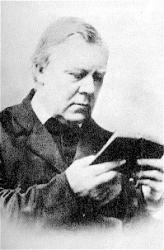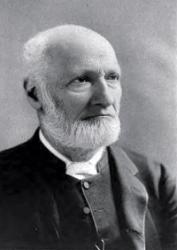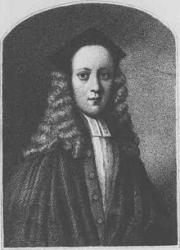Planning worship?
Check out our sister site, ZeteoSearch.org,
for 20+ additional resources related to your search.
- |
User Links
Person Results
George Keith
1638 - 1716 Author of "How Firm a Foundation" in Church Hymnal, Mennonite George Keith, according to D. Sedgwick, was the author of "How firm a foundation, ye saints of the Lord." Little is known about Keith, save that he was a publisher, a son-in-law of Dr. Gill, and the composer of several hymns.
--Annotations of the Hymnal, Charles Hutchins, M.A. 1872.
George Keith
John Paul Cragin
Person Name: J. Paul Cragin Translator of "Venid Fieles Todos" in Melodias Evangélicas Brother of Howard W. Cragin (Melodias Evangélicas: Nuevo Cantos y Coros de Despertamiento Cristiano, #181).
John Paul Cragin
John Francis Wade
1711 - 1786 Person Name: John Francis Wade, 1711-1786 Probable author, vv. 1-4 of "Adeste Fideles" in TTT-Himnaro Cigneta John Francis Wade (b. England, c. 1711; d. Douay, France, 1786) is now generally recognized as both author and composer of the hymn "Adeste fideles," originally written in Latin in four stanzas. The earliest manuscript signed by Wade is dated about 1743. By the early nineteenth century, however, four additional stanzas had been added by other writers. A Roman Catholic, Wade apparently moved to France because of discrimination against Roman Catholics in eighteenth-century England—especially so after the Jacobite Rebellion of 1745. He taught music at an English college in Douay and hand copied and sold chant music for use in the chapels of wealthy families. Wade's copied manuscripts were published as Cantus Diversi pro Dominicis et Festis per annum (1751).
Bert Polman
John Francis Wade
João Marques da Mota Sobrinho
1883 - 1964 Person Name: João Marques da Mota Sobrinho (1883-1964) Translator of "Entre nuvens multicores (1)" in Mil Vozes para Celebrar
João Marques da Mota Sobrinho
John Franklin Genung
1850 - 1919 Person Name: John F. Genung Author of "O, Praise ye the Father" in Select Songs No. 2
John Franklin Genung
Edward Caswall

1814 - 1878 Person Name: E. Caswall Translator of "Come Hither, ye Faithful" in Concordia Edward Caswall was born in 1814, at Yately, in Hampshire, where his father was a clergyman. In 1832, he went to Brasenose College, Oxford, and in 1836, took a second-class in classics. His humorous work, "The Art of Pluck," was published in 1835; it is still selling at Oxford, having passed through many editions. In 1838, he was ordained Deacon, and in 1839, Priest. He became perpetural Curate of Stratford-sub-Castle in 1840. In 1841, he resigned his incumbency and visited Ireland. In 1847, he joined the Church of Rome. In 1850, he was admitted into the Congregation of the Oratory at Birmingham, where he has since remained. He has published several works in prose and poetry.
--Annotations of the Hymnal, Charles Hutchins, M.A. 1872
=====================
Caswall, Edward, M.A., son of the Rev. R. C. Caswall, sometime Vicar of Yately, Hampshire, born at Yately, July 15, 1814, and educated at Brasenose College, Oxford, graduating in honours in 1836. Taking Holy Orders in 1838, he became in 1840 Incumbent of Stratford-sub-Castle, near Salisbury, and resigned the same in 1847. In 1850 (Mrs. Caswall having died in 1849) he was received into the Roman Catholic communion, and joined Dr. Newman at the Oratory, Edgbaston. His life thenceforth, although void of stirring incidents, was marked by earnest devotion to his clerical duties and a loving interest in the poor, the sick, and in little children. His original poems and hymns were mostly written at the Oratory. He died at Edgbaston, Jan. 2, 1878, and was buried on Jan. 7 at Redwall, near Bromsgrove, by his leader and friend Cardinal Newman. Caswall's translations of Latin hymns from the Roman Breviary and other sources have a wider circulation in modern hymnals than those of any other translator, Dr. Neale alone excepted. This is owing to his general faithfulness to the originals, and the purity of his rhythm, the latter feature specially adapting his hymns to music, and for congregational purposes. His original compositions, although marked by considerable poetical ability, are not extensive in their use, their doctrinal teaching being against their general adoption outside the Roman communion. His hymns appeared in:—
(1) Lyra Catholica, which contained 197 translations from the Roman Breviary, Missal, and other sources. First ed. London, James Burns, 1849. This was reprinted in New York in 1851, with several hymns from other sources added thereto. This edition is quoted in the indices to some American hymn-books as Lyra Cath., as in Beecher's Plymouth Collection, 1855, and others.
(2) Masque of Mary, and Other Poems, having in addition to the opening poem and a few miscellaneous pieces, 53 translations, and 51 hymns. 1st ed. Lon., Burns and Lambert, 1858.
(3) A May Pageant and Other Poems, including 10 original hymns. Lon., Burns and Lambert, 1865.
(4) Hymns and Poems, being the three preceding volumes embodied in one, with many of the hymns rewritten or revised, together with elaborate indices. 1st ed. Lon., Burns, Oates & Co., 1873. Of his original hymns about 20 are given in the Roman Catholic Crown of Jesus Hymn Book, N.D; there are also several in the Hymns for the Year, N.D., and other Roman Catholic collections.
--John Julian, Dictionary of Hymnology (1907)
======================
Caswall, E. , p. 214, ii. Additional original hymns by Caswall are in the Arundel Hymns, 1902, and other collections. The following are from the Masque of Mary, &c, 1858:—
1. Christian soul, dost thou desire. After Holy Communion.
2. Come, let me for a moment cast. Holy Communion.
3. O Jesu Christ [Lord], remember. Holy Communion.
4. Oft, my soul, thyself remind. Man's Chief End.
5. Sleep, Holy Babe. Christmas. Appeared in the Rambler, June 1850, p. 528. Sometimes given as "Sleep, Jesus, sleep."
6. The glory of summer. Autumn.
7. This is the image of the queen. B. V. M.
His "See! amid the winter's snow,” p. 1037, i., was published in Easy Hymn Tunes, 1851, p. 36. In addition the following, mainly altered texts or centos of his translations are also in common use:—
1. A regal throne, for Christ's dear sake. From "Riches and regal throne," p. 870, ii.
2. Come, Holy Ghost, Thy grace inspire. From "Spirit of grace and union," p. 945, i.
3. Hail! ocean star, p. 99, ii,, as 1873. In the Birmingham Oratory Hymn Book, 1850, p. 158.
4. Lovely flow'rs of martyrs, hail. This is the 1849 text. His 1873 text is "Flowers of martyrdom," p. 947, i.
5. None of all the noble cities. From "Bethlehem! of noblest cities," p. 946, ii.
6. O Jesu, Saviour of the World. From “Jesu, Redeemer of the world," p. 228, ii.
7. 0 Lady, high in glory raised. From "O Lady, high in glory, Whose," p. 945, i.
The Parochial Hymn Book, 1880, has also the following original hymns by Caswall. As their use is confined to this collection, we give the numbers only:—
IS os. 1, 2, 3, 159 (Poems, 1873, p. 453), 209 (1873, p. 288), 299, 324 (1873, p. 323), 357, 402, 554, 555, 558, 569 (1873, p. 334). These are from his Masque of Mary 1858. Nos. 156, 207 (1873, p. 296), 208 (1873, p. 297), 518. These are from his May Pageant, 1865.
As several of these hymns do not begin with the original first lines, the original texts are indicated as found in his Poems, 1873. [Rev. James Mearns, M.A.]
--John Julian, Dictionary of Hymnology, New Supplement (1907)
Edward Caswall
Philip Schaff

1819 - 1893 Translator of "Oh, Come, All Ye Faithful" in The Lutheran Hymnal Schaff, Philip, D.D., LL.D., was born at Chur, Switzerland, Jan. 1, 1819. He studied at the Universities of Tübingen, Halle, and Berlin. In 1843 he was appointed a Professor in the German Reformed Theological Seminary at Mercersburg, Pennsylvania, U.S.A., and in 1870 Professor of Sacred Literature in the Union Seminary, New York. As translator, author, and editor, Dr. Schaff holds high rank, both in Great Britain and America. The various Histories and Encyclopedias which he has edited are standard works. His knowledge of hymnology is extensive, and embraces hymns in many languages and of all ages, his speciality being German hymnody. The hymnological works which he has edited alone, or jointly with others, are:—
(1) Deutsches Gesangbuch, 1860; (2) Christ in Song, a most valuable collection of original English and American hymns, and translated hymns, N.Y. 1869, London, 1870; (3) Hymns and Songs of Praise for Public and Social Worship, 1874, in which he was assisted by Boswell D. Hitchcock, and Zachary Eddy; (4) Library of Religious Poetry, 1881, of which A. Gilman was joint editor.
Dr. Schaff has not composed any original hymns. His translations from the Latin are meritorious. He died Oct. 20, 1893.
--John Julian, Dictionary of Hymnology (1907)
Philip Schaff
K.
Author of "¡Cuán Firme Cimiento!" in El Himnario In John Rippon's A Selection of Hymns (1787, plus numerous subsequent editions), "How Firm a Foundation" (no. 128) is attributed simply to "K—". Two other hymns in the collection bear the same mark, "In songs of sublime adoration and praise," and "The Bible is justly esteemed." The author of the hymn has never been definitively identified, but the most common candidates are listed below.
I. Robert Keen(e)
The most likely possibility is Robert Keene, who served as precentor at Rippon's church. The evidence for connecting K with Keene comes (1) from his close acquaintance with Rippon, (2) Rippon's tune book, and (3) the testimony (of sorts) of Thomas Walker.
After Rippon started publishing a tune book, A Selection of Psalm and Hymn Tunes (1792), to go with his hymnal, both books were cross-referenced against each other; the tunes suggested for "How Firm a Foundation" were GEARD (no. 156) and BROUGHTON (no. 172). Both GEARD and BROUGHTON first appeared in Rippon's tune book and were probably written for it. BROUGHTON is by T. [Thomas] Walker., and GEARD is by R. [Robert] Keene, thus the association with "K.", but the connection is speculative at best.
Julian, in his article on "How Firm" in the Dictionary of Hymnology, notes that Walker later assisted Alexander Fletcher with his A Collection of Hymns (1822), and in that collection the text is attributed to Keen.
II. George Keith
In Josiah Miller's Singers and Songs of the Church (1869), "How Firm" is attributed to George Keith. According to Julian, the motivation behind this attribution was Daniel Sedgwick—-Miller credits him in the preface with having contributed special hymnological knowledge--yet Julian notes that Sedgwick garnered his information from "an old woman whom Sedgwick met in an almshouse." Keith was a publisher in London, and was the son-in-law of Dr. Gill, Rippon's distinguished predecessor at Carter Lane.
III. Thomas Kirkham
In 19th century editions of Rippon's Selection, the hymn was attributed to "Kirkham." Thomas Kirkham published A Collection of Hymns in 1788, yet "How Firm" was not included. His connection to Rippon is unclear.
IV. Kennedy/Kennady
Still other collections offer a different possiblity: a Kennedy or Kennady. This attribution appears as early as 1826 in Nettleton's Village Hymns. In Spurgeon's Our Own Hymn Book (1866), he offers "Kirkham or Kennedy, 1787." This person has yet to be identified.
V. John Rippon
In his preface to the Selection, Rippon wrote:
In most places, where the names of the authors were known, they are put at full length, but the hymns which are not so distinguished, or which have only a single letter prefixed to them, were, many of them composed by a person unknown, or else have undergone some considerable alterations.
Since Rippon is known to have significantly altered hymns in his collection ("All hail the power of Jesus' name," being a notable example), Rippon likely deserves at least partial credit for texts bearing the mark "K."
—Chris Fenner
with contributions from Eric Stedfeld, Peter Irvine, and Peter Rehwaldt
See also "How Firm a Foundation".
K.
John Byrom

1692 - 1763 Person Name: Byrom Author of "The Lord is our Shepherd, our Guardian and Guide" in Christian Life Songs John Byrom was born in 1691, at Manchester, where his father was a linen-draper. He entered Trinity College, Cambridge, 1708; became a Fellow of the College in 1714; took his M.A. in 1716, and then proceeded to Montpelier, where he studied medicine. He afterwards abandoned medicine, settled in London, and obtained his living by teaching a system of shorthand, which he had projected. He was elected a member of the Royal Society in 1724. He died Sept. 28, 1763. The first edition of Byrom's poems appeared in 1773, in two volumes. A more complete edition was published in 1814. Byrom did not seek publicity as an author, but wrote verses only for recreation.
--Annotations of the Hymnal, Charles Hutchins, M.A., 1872
======================
Byrom, John, M.A., F.R.S., born at Manchester, Feb. 29,1691-2, baptized the same day, and educated at Merchant Taylors' School, and Trinity College, Cambridge, where he graduated B.A. 1712 ; M.A. 1715. He was elected a Fellow of his College in 1714. After studying medicine for a time at Montpellier, he returned to London, and earned his livelihood by teaching shorthand. Elected F.R.S. in 1724, and succeeded to the family estates about the same time. He died Sept. 28, 1763. His Poems were first published in 1773, in two volumes. In 1814 a more complete edition was issued by Nichols, of Leeds. From these Poems less than half a dozen hymns have come into common use. One of these, however, has a repu¬tation which has extended to all English-speaking countries. We refer to his "Christians, awake!" (q.v.). His hymn, "My spirit longeth for Thee," is also worthy of attention.
-- John Julian, Dictionary of Hymnology (1907)
John Byrom


 My Starred Hymns
My Starred Hymns

